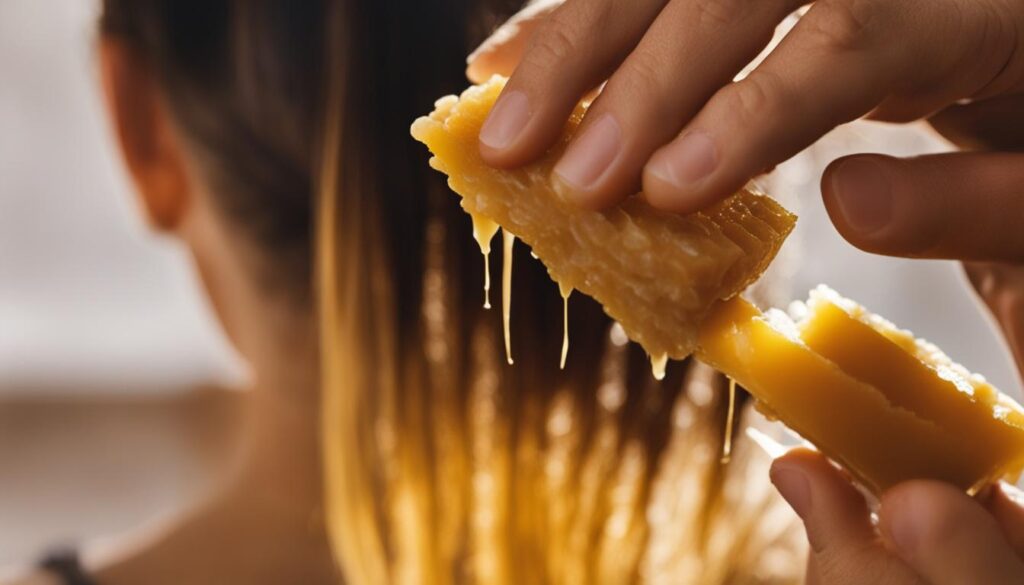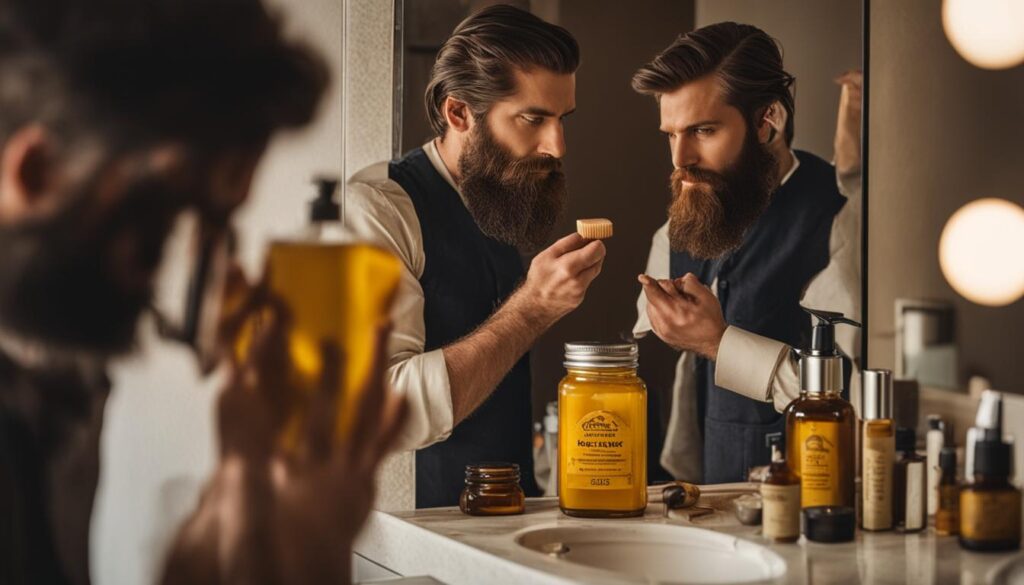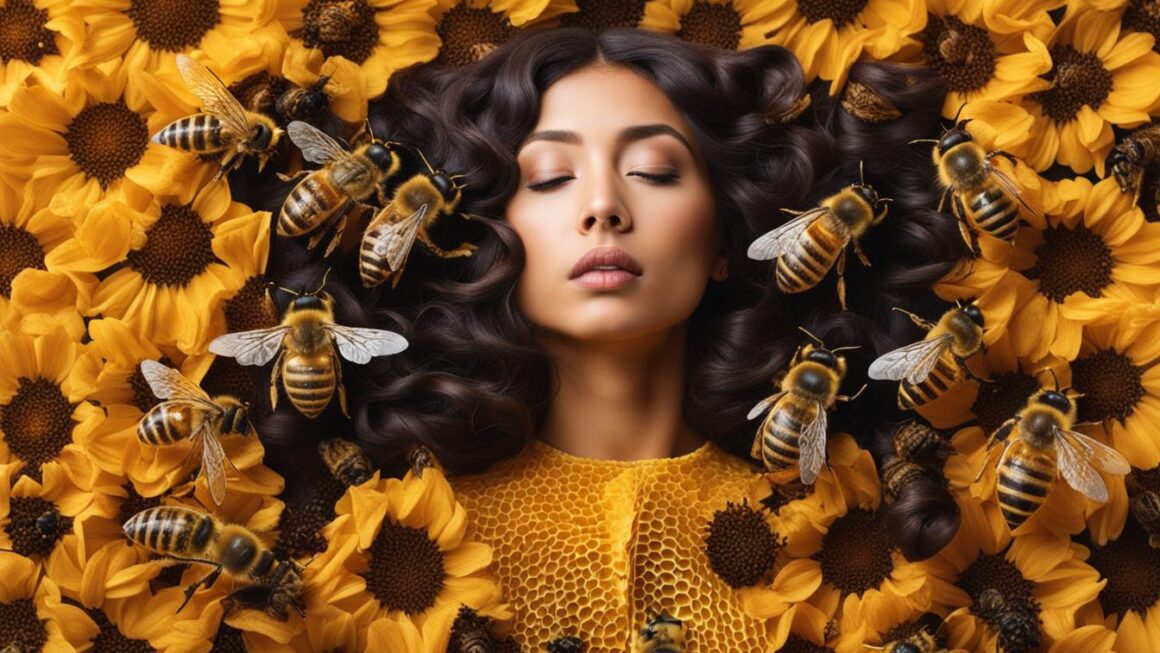Welcome to our ultimate guide on using beeswax to boost hair growth naturally. Beeswax has been cherished for centuries for its remarkable moisturizing and styling properties. Not only can it help moisturize and seal strands, but it also promotes hair growth, smoothens and straightens hair, and soothes the scalp. In fact, studies have shown that a hair wax containing beeswax can significantly increase hair length.
If you’re interested in harnessing the benefits of beeswax for hair growth, it’s important to apply it sparingly and avoid daily use to prevent product buildup. We’ll also explore the fascinating world of DIY recipes that allow you to create your own beeswax hair products, such as pomades and balms.
Key Takeaways:
- Beeswax has moisturizing and styling properties that can benefit your hair.
- Applying beeswax sparingly can promote hair growth and soothe the scalp.
- Avoid daily use of beeswax to prevent product buildup and clogged pores.
- DIY recipes allow you to create personalized beeswax hair products.
- Remember to use warm olive oil to remove beeswax buildup when necessary.
What is Beeswax and How Does it Benefit Your Hair?
Beeswax is a natural substance produced by worker bees to build honeycombs. It is a versatile ingredient that offers numerous benefits for your hair. Rich in moisturizing vitamin A and small amounts of antibacterial agents, beeswax can help nourish and protect your hair.
One of the key benefits of beeswax for hair is its moisturizing properties. It helps to lock in moisture, preventing dryness and brittleness. This can lead to healthier, more manageable hair. Additionally, beeswax can help smooth and straighten strands, reducing frizz and flyaways.
Not only does beeswax promote hair health, but it also supports hair growth. By moisturizing and sealing the hair shaft, beeswax creates a favorable environment for hair growth. It can also help soothe the scalp, reducing itchiness and irritation.
“Beeswax is a versatile ingredient that offers numerous benefits for your hair.”
When using beeswax for hair care, it is important to apply it sparingly and avoid daily use to prevent buildup. Excessive buildup can lead to waxy residue and weigh down your hair. By using beeswax in moderation, you can enjoy its benefits without these drawbacks.
With its natural moisturizing properties and ability to promote hair growth, beeswax is a valuable ingredient to incorporate into your hair care routine.
What is Beeswax and How Does it Benefit Your Hair?
Using Beeswax for Your Hair: Tips and Techniques
When it comes to using beeswax for your hair, there are a few key tips and techniques to keep in mind. By following these recommendations, you can maximize the benefits of beeswax for hair care and growth.
Applying Beeswax
To apply beeswax to your hair, it is best to start with wet or damp hair. This allows the beeswax to distribute more evenly and effectively throughout your strands. Begin with a small amount of beeswax and warm it up between your hands. Then, gently rub the beeswax onto your hair, focusing on the areas where you want to achieve hold or added moisture.
It’s important to avoid using beeswax every day, as this can lead to product buildup. Instead, aim for every few days or as needed. If you find that you need to remove beeswax from your hair, warm olive oil can be effective in breaking down the wax and allowing for easy removal.
Protective Measures
When using beeswax for your hair, it’s beneficial to take protective measures to minimize potential damage or adverse effects. Consider wearing a silk or satin headscarf at night to reduce the frequency of applying beeswax. This can help keep your hair moisturized and prevent excessive product buildup.
Additionally, it’s important to avoid applying beeswax directly to your scalp. Beeswax can clog pores and potentially cause scalp issues. Instead, focus on applying the product to the mid-lengths and ends of your hair, where it can provide the most benefits.

Trial and Error
When using beeswax for hair care and growth, it may take some trial and error to find the right amount and technique that works best for you. Start with a small amount and gradually increase as needed. Be mindful of how your hair responds to the beeswax and adjust accordingly.
- Experiment with different beeswax-based hair products to find the one that suits your hair type and styling preferences.
- If you prefer a DIY approach, try creating your own beeswax hair products, such as pomades or balms. This allows you to customize the ingredients to cater to your hair’s specific needs.
- Remember that consistency is key. Regular use of beeswax can help maintain the desired style and provide ongoing nourishment to your hair.
By following these tips and techniques, you can harness the power of beeswax for your hair care routine. Whether you’re looking to add moisture, hold, or promote growth, beeswax can be a valuable natural ingredient to incorporate into your hair care regimen.
Beeswax for Dreadlocks
Dreadlocks, also known as locs, are a popular hairstyle that requires careful maintenance to keep them looking neat and well-formed. Beeswax is commonly used in the creation and maintenance of dreadlocks due to its ability to hold the hair in place, especially during the early stages of dreadlock formation.
To create dreadlocks using beeswax, start by separating your hair into sections. Next, coat each section with beeswax by rolling the hair between your palms. As you work the beeswax into your hair, twist each section in the same direction to form the dreadlocks. This process helps the hair hold its shape and promotes the locking process.
It is important to note that beeswax should be used sparingly when creating and maintaining dreadlocks. Excessive use of beeswax can lead to buildup and make it difficult to remove the product from the hair. Additionally, it is recommended to avoid washing your hair for about a week after applying beeswax to allow the dreadlocks to set and hold their shape.
Beeswax can be a helpful tool in achieving and maintaining well-formed dreadlocks. However, it is important to balance its use with proper care and maintenance to avoid excessive buildup and ensure the health of your hair.
Tips for Using Beeswax for Dreadlocks:
- Start with clean, dry hair before applying beeswax.
- Use a small amount of beeswax to avoid buildup.
- Apply the beeswax by rolling it between your palms and working it into each section of hair.
- Twist each section in the same direction to form the dreadlocks.
- Allow the dreadlocks to set for about a week before washing your hair.
- Regularly clean your dreadlocks to prevent buildup and maintain their appearance.
Beeswax for Beards
Beeswax is not only beneficial for hair growth but also for styling and maintaining beards. Its moisturizing properties help keep the beard hydrated, preventing dryness and itchiness. Additionally, beeswax acts as a natural sealant, keeping dirt and grime away from the beard.
Using beeswax for styling beards is a popular choice among men. It provides a firm hold, allowing you to shape and groom your beard according to your desired style. Whether you’re going for a sleek and polished look or a more natural and textured appearance, beeswax can help you achieve it.
Beeswax for beards not only moisturizes and styles but also acts as a sealant to repel dirt and grime.
Creating your own beard wax or balm using beeswax is a great option for those who prefer natural and DIY grooming products. By combining beeswax with ingredients like shea butter, carrier oils, and essential oils, you can tailor the mixture to your specific beard care needs. Apply a small amount of the homemade product to your hands and distribute it evenly throughout your beard for a well-groomed and conditioned look.
When working with beeswax for beards, it’s important to ensure proper removal to avoid clogging the pores. Use warm olive oil or other suitable removal methods to effectively remove beeswax residue from your beard.

Beard Care Tips:
- Regularly wash and condition your beard to keep it clean and healthy.
- Use a beard brush or comb to detangle and style your beard.
- Trim your beard regularly to maintain its shape and prevent split ends.
- Apply beard oil or balm to moisturize and nourish the hair and skin beneath the beard.
- Avoid excessive heat styling tools on your beard, as they can cause damage.
Incorporating beeswax into your beard care routine can help you achieve a well-groomed and stylized beard while keeping it moisturized and protected.
Beeswax for Hair Removal
Beeswax is a versatile natural ingredient that is not only beneficial for promoting hair growth and styling, but it can also be used effectively for hair removal. Its sticky texture and adhesive properties make it ideal for removing unwanted hair from various parts of the body.
When using beeswax for hair removal, it is important to follow the proper technique. To create a homemade beeswax hair removal mixture, you can combine beeswax with other ingredients such as honey, lemon juice, and essential oils. Heat the mixture until the beeswax melts and forms a smooth consistency. Allow it to cool slightly before applying it to the desired areas.
Apply the warm beeswax mixture onto the skin in the opposite direction of hair growth, making sure to cover the entire area. Quickly place a cloth strip or waxing paper over the wax and firmly press it down. Hold the skin taut and swiftly pull off the strip in the opposite direction of hair growth to remove the hair.
Benefits of Using Beeswax for Hair Removal
- Effective hair removal: Beeswax adheres to the hair and pulls it out from the root, resulting in longer-lasting hair removal compared to shaving or using depilatory creams.
- Natural and gentle: Beeswax is a natural alternative to chemical-laden hair removal methods. It is gentle on the skin and less likely to cause irritation or allergies.
- Moisturizing properties: Unlike other hair removal methods, beeswax leaves the skin moisturized and smooth after hair removal.
“Using beeswax for hair removal provides a natural and effective way to remove unwanted hair, leaving the skin smooth and moisturized.” – Expert Dermatologist
It is important to note that while beeswax can be an effective hair removal method, it may not be suitable for everyone. People with sensitive skin or allergies to bee products should avoid using beeswax for hair removal. It is always recommended to do a patch test before applying beeswax to a larger area of the body to check for any adverse reactions.
In conclusion, beeswax can be a natural and effective option for hair removal. Whether you choose to make your own beeswax hair removal mixture or purchase commercial wax products, beeswax offers a gentle and moisturizing alternative to chemical-based hair removal methods.
Downsides of Beeswax
While beeswax offers many benefits for hair, it’s important to be aware of the potential downsides. One of the main drawbacks of beeswax is the waxy buildup it can leave in the hair. Over time, this buildup can make the hair look dull, heavy, and difficult to manage.
Removing beeswax buildup can be a challenge, requiring the use of warm olive oil or other removal methods. It’s crucial to use beeswax sparingly to prevent excessive buildup and avoid applying it directly to the scalp, as this can clog the pores and lead to other scalp issues.
Additionally, beeswax can leave a sticky residue that may stain clothing and furniture. To minimize the risk of staining, it’s best to avoid touching or resting your hair on surfaces immediately after applying beeswax. Taking precautions such as using a towel or headscarf can help protect your belongings from any potential marks.
FAQ
How can I use beeswax for hair growth?
Beeswax can be applied sparingly to wet or damp hair to moisturize and seal strands, promote hair growth, and soothe the scalp. It is important to avoid daily use to prevent buildup.
What are the benefits of using beeswax for hair?
Beeswax can moisturize hair, help smooth and straighten strands, seal split ends, promote hair growth, and soothe the scalp.
How do I use beeswax for dreadlocks?
To create dreadlocks using beeswax, separate hair into sections, coat each section with beeswax, and twist the sections in the same direction. Avoid washing the hair for about a week to allow the dreadlocks to set.
Can I use beeswax for my beard?
Yes, beeswax is commonly used in beard waxes and balms to moisturize and hold the beard in place, while also acting as a sealant to repel dirt and grime.
How do I remove beeswax from my hair?
Beeswax can be challenging to remove, but using warm olive oil or other removal methods can help. It is important to remove beeswax properly to avoid pore clogging.
Can beeswax be used for hair removal?
Yes, beeswax is commonly used in hair removal waxes. It can effectively remove hair when applied and pulled off in the opposite direction of hair growth.
Are there any downsides to using beeswax?
Beeswax can cause waxy buildup in the hair, which can be difficult to remove. It can also leave a sticky residue that may stain clothing and furniture. It is important to use beeswax sparingly to prevent buildup and to avoid applying beeswax to the scalp, as it can clog pores.




